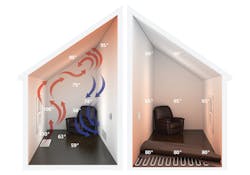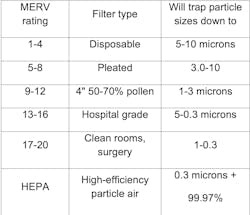I want to talk about COVID-19, but I want to make it very clear from the beginning that I am not a doctor. When I was young, I did want to be a doctor. But, then I found out you had to have a high school diploma, and that ended that.
Having given the disclaimer, you don’t need to be a doctor to see that the coronavirus has changed the world. Many of the changes will be permanent —or at least some variation of permanently different. Which means that whatever business model for construction you were using yesterday will also have to change, or you will lose business tomorrow. More to the point, you will miss business opportunities tomorrow.
Working from home these past several months has shown that for many people in the workplace with office-type jobs, it is indeed possible to work from home with little or no loss of production. Many people that I talk to say they are busier than ever working from home, and with technology what it is, they feel they are getting more done with fewer interruptions.
I suspect that part of the fallout of this will be fewer commercial office spaces built and a huge spike in remodeling construction, as current office facilities are being repurposed and reimagined for the post-COVID world.
I believe that the re-pipe and reconstruction business could pass the commercial new-construction business within two years, as building owners scramble to realign with the new normal.
Weakness exposed
Not surprisingly, one thing that has really changed since all of this started is that the conversation around indoor environmental quality, or IEQ, has exploded. How we build and how we live in these buildings is going to change—you can count on it.
The coronavirus has exposed the weaknesses of our indoor climate systems to protect us. Not just from the virus, but also allergens, volatile organic compounds (VOCs), microbial contaminants (such as mold and bacteria), gases (such as carbon monoxide and radon), and carcinogens such as asbestos, formaldehydes used in glues, styrenes used in fragrances, lead, PCBs, and coming soon — PVC, commonly found in toys and shower curtains. As it turns out, a well-vacuumed and well-shampooed carpet has 4,000 times more bacteria living in it than is on your toilet seat.
So, it would seem that the best thing you could become tomorrow is more well-versed in ventilation and infiltration. It will profit you to know how filtration works, how to decrease infiltration and increase ventilation with a minimum loss of heat energy.
New technologies are appearing on the market to address these COVID issues, like ultraviolet germicidal irradiation and needlepoint bipolar ionization, which are being used in commercial spaces to go to war against the virus with the side benefit that our indoor spaces will become safer and healthier. The important takeaway is that the building-systems types are going to change, and there may be greater opportunities for retrofitting existing buildings. This could translate to more re-pipe opportunities.
Picture a basketball: It contains almost exactly 1 cubic foot of air. With half air change per hour, we are taking 12,000 basketballs full of heated, filtered, dehumidified air and putting them outside, while bringing in another 12,000 basketballs that need to be reheated, filtered, and dehumidified. This is the cost of having healthy air.
But let’s say that the infiltration/exfiltration of the house—through cracks in the walls, large oven fans, leaks around doors and windows—adds another half air change per hour, which is not unusual at all.
That means you are losing 24,000 basketballs of heated, filtered, dehumidified air, putting it outside, and bringing in all that unheated, unfiltered air into the house every hour of every day of the heating season. If this house was built back in the 1950s or ‘60s, it could be even more than that. Environmentally and economically, caulking up the cracks is just as important as how much insulation we put around a house.
What if someone is sick?
Apart from the tremendous loss of heat and conditioned air, if someone in the house who is infected with the virus is coughing and sneezing, tiny virus particles in respiratory droplets could be circulated in the air.
Anything that moves air currents around the room can spread these droplets: an air conditioning system, a window-mounted AC unit, a forced-air heating system, or even a fan. As you can see, infiltration and exfiltration directly affect the movement of air in a space.
Counting on the furnace filter to stop the spread? It is almost no help at all. Imagine standing in front of a chain-link fence with a pile of BBs in your hand. One by one, you throw a BB at the chain-link fence. What do you think the odds are that the chain-link fence will stop even one BB? A BB to a chain-link fence is a fairly accurate representation of the coronavirus to a home-furnace filter.
Indeed, furnace filters are of little value as far as health goes. Did you know that those filters are not meant to purify the air you breathe? Who knew? Their sole function is to keep larger particles of dirt, dust, hair, etc. from clogging the furnace and air-conditioning equipment.
Dirt, hair, etc. can clog coils, coat electric motors (causing overheating), and coat fan blades (causing inefficient air movement). The typical fiberglass furnace filter doesn’t meet a single requirement of nursing homes’ and hospitals’ filtration needs. They don’t even stop that much dust and hair. That’s why this country has a thriving duct-cleaning service business.
Minimum filter efficiencies are specified in Table 6-4 of ASHRAE Standard 170-2013. The MERV ratings are based on a test described in Appendix J of Standard 52.2. The MERV ratings more accurately predict filter efficiency over time, so hospitals and design engineers should require MERV-A ratings when ordering or specifying filters.
Below is a chart that will help you distinguish the different MERV ratings of filters.
The coronavirus itself measures 0.06 to 1.4 microns (based on varying expert opinions). They are most often connected to a moisture droplet, which brings their size up in the range where HEPA filters are more successful. We have a ways to go yet
So this is where we are headed. In that vein, it makes sense to start focusing on indoor climate systems that actually don’t have anything to do with circulating the air—like hydronics. Hydronic hot-water heating, chilled-water cooling, and radiant heating and cooling systems can provide better IEQ and, in turn, better health.
It’s a fact that your choice of heating and cooling systems does make a difference. In this new era of the coronavirus, we need to start focusing on building solutions that will have a positive effect in terms of health, comfort, and energy efficiency.
I would be grateful to hear your thoughts, ideas and stories. Until the next time, best regards and happy heating.
Steve Swanson is the customer trainer at Uponor Academy in Apple Valley, Minnesota. He actively welcomes reader comments and questions at [email protected].
About the Author
Steve Swanson
Steve Swanson is the customer trainer at Uponor Academy. He actively welcomes reader comments and can be reached at [email protected].


